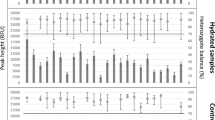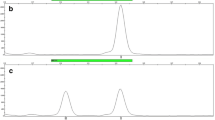Abstract
Analysis of DNA polymorphisms are the primary technique used for personal identification in forensic cases. However, DNA samples collected as evidence from crime scenes are usually degraded by environmental, physical, and chemical factors, which may interfere with the PCR analysis and, consequently, personal identification. Whole genome amplification (WGA) is a useful method to amplify genomic DNA from samples containing low quantity and poor quality of DNA, and it approach that shows promise to overcome the limited small fragments based upon random fragmentation by universal priming sites. In this study, we describe the use of WGA to genotype 15 short tandem repeat (STR) loci from dried blood samples irradiated with different types of ultraviolet (UV) light (UVA, UVB, and UVC). The result showed that UVC was the most damaging to DNA, followed by UVB and UVA. Samples exposed to UVA could be genotyped for all STR loci with or without WGA. For UVB and UVC irradiated blood samples, a greater number of STR loci could be genotyped after WGA. Although it hard to amplified a few higher molecular weight alleles, overall, the WGA method was useful in genotyping template DNA of poor quality but low quantity.



Similar content being viewed by others
References
Kayser M (2015) Forensic DNA phenotyping: predicting human appearance from crime scene material for investigative purposes. Forensic Sci Int Genet 18:33–48
Friedberg EC (2003) DNA damage and repair. Nature 421:436–440
Hall A, Ballantyne J (2004) Characterization of UVC-induced DNA damage in bloodstains: forensic implications. Anal Bioanal Chem 380:72–83
Poepping C, Beck SE, Wright H, Linden KG (2014) Evaluation of DNA damage reversal during medium-pressure UV disinfection. Water Res 56:181–189
Vaisman A, Woodgate R (2017) Translesion DNA polymerases in eukaryotes: what makes them tick? Crit Rev Biochem Mol Biol 52(3):274–303
Diegoli TM, Farr M, Cromartie C, Coble MD, Bille TW (2012) An optimized protocol for forensic application of the PreCR™ Repair Mix to multiplex STR amplification of UV-damaged DNA. Forensic Sci Int Genet 6(4):498–503
Hall A, Sims LM, Ballantyne J (2014) Assessment of DNA damage induced by terrestrial UV irradiation of dried bloodstains: forensic implications. Forensic Sci Int Genet 8(1):24–32
Rinke J, Schäfer V, Schmidt M, Ziermann J, Kohlmann A, Hochhaus A, Ernst T (2013) Genotyping of 25 leukemia-associated genes in a single work flow by next-generation sequencing technology with low amounts of input template DNA. Clin Chem 59(8):1238–1250
Han T, Chang CW, Kwekel JC, Chen Y, Ge Y, Martinez-Murillo F, Roscoe D, Težak Z, Philip R, Bijwaard K, Fuscoe JC (2012) Characterization of whole genome amplified (WGA) DNA for use in genotyping assay development. BMC Genom 13(217):1–15
Huang L, Ma F, Chapman A, Lu S, Xie XS (2015) Single-cell whole-genome amplification and sequencing: methodology and applications. Annu Rev Genomics Hum Genet 16:79–102
Borgström E, Paterlini M, Mold JE, Frisen J, Lundeberg J (2017) Comparison of whole genome amplification techniques for human single cell exome sequencing. PLoS ONE 12(2):e0171566
Lindahl T (1993) Instability and decay of the primary structure of DNA. Nature 362:709–715
Robertson JM, Dineen SM, Scott KA, Lucyshyn J, Saeed M, Murphy DL, Schweighardt AJ, Meiklejohn KA (2014) Assessing PreCR™ repair enzymes for restoration of STR profiles from artificially degraded DNA for human identification. Forensic Sci Int Genet 12:168–180
Mitchell D, Willerslev E, Hansen A (2005) Damage and repair of ancient DNA. Mutat Res 571:265–276
Tate CM, Nuñez AN, Goldstein CA, Gomes I, Robertson JM, Kavlick MF, Budowle B (2012) Evaluation of circular DNA substrates for whole genome amplification prior to forensic analysis. Forensic Sci Int Genet 6(2):185–190
Kroneis T, El-Heliebi A (2015) Quality control of isothermal amplified DNA based on short tandem repeat analysis. Methods Mol Biol 1347:129–140
Lee JC, Tsai LC, Lai PY, Lee CC, Lin CY, Huang TY, Linacre A, Hsieh HM (2012) Evaluating the performance of whole genome amplification for use in low template DNA typing. Med Sci Law 52(4):223–228
Nishikawa Y, Hosokawa M, Maruyama T, Yamagishi K, Mori T, Takeyama H (2015) Monodisperse picoliter droplets for low-bias and contamination-free reactions in single-cell whole genome amplification. PLoS ONE 10(9):e0138733
Acknowledgements
We thank Mr. Eiji Isobe for assistance with the samples irradiation.
Author information
Authors and Affiliations
Corresponding author
Ethics declarations
Conflict of interest
The authors declare that they have no conflict of interest.
Ethical approval
Approval for this study was granted by the Ethics Committee of Nihon University School of Medicine and National Research Committee. All procedures performed in studies involving human participants were in accordance with the ethical standards of this Ethics Committee and with the 1964 Helsinki declaration and its later amendments or comparable ethical standards.
Informed consent
Informed consent was obtained from all participants included in the study.
Rights and permissions
About this article
Cite this article
Uchigasaki, S., Tie, J., Sobashima, E. et al. Genotyping DNA isolated from UV irradiated human bloodstains using whole genome amplification. Mol Biol Rep 45, 925–929 (2018). https://doi.org/10.1007/s11033-018-4240-6
Received:
Accepted:
Published:
Issue Date:
DOI: https://doi.org/10.1007/s11033-018-4240-6




